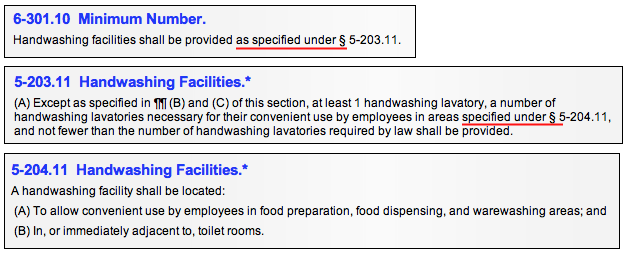Reading the Food Code
While the Code contains a lot of useful information and resources regarding food safety and the prevention of foodborne disease transmission, it is important to understand how the Code is organized and how it should be read.
Code Drafting Conventions
The structural nomenclature of the Food Code takes the following order:
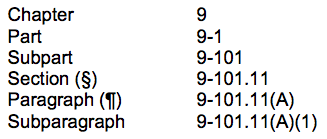
If section numbers end in .#0 or .#00, they are considered for information only and are non debitable provisions, so they are not recorded on inspections as violations because they are not written as violatable provisions.
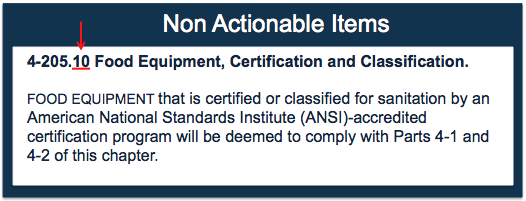
Equipment that is certified by an accredited certification program is a method of satisfying the equipment requirements (deemed status). The equipment requirements are satisfied if the equipment criteria in §4-205.10 is met. If the criteria is not met, then the equipment must be evaluated on the spot to determine acceptability or deficiencies.
NOTE: Chapter 8 has many provisions that are not debitable, for example, §8-202.10 requires the Regulatory Authority to hold confidential, trade secrets.
Conventions
The Code is organized in a "logical sense" and requires the user to think about what requirement they want to find. Basing provisions on principle rather than subject requires cross referencing but results in fewer words. The Code would be much larger if it addressed all requirements for refrigerators, then for sinks, then for ventilation systems, etc. As a result, extensive cross-referencing is used to avoid repetition.
There is a list of Parts at the beginning of each Chapter.
Example #1:
As illustrated below, the structure and flow of the "Parts" section found at the beginning of Chapter 3 of the Code follows a logical sequence - source, receiving, protection after receipt, contaminated food, addressing susceptible populations.
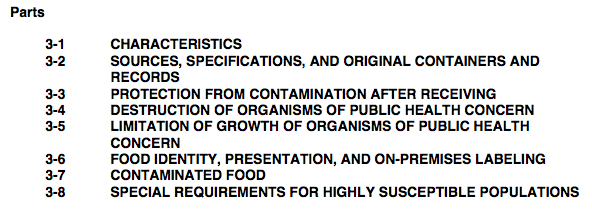
Example #2:
Illustrated below, the sequence of sections found in Chapter 4 is also logical starting first with materials needed for construction and repair, followed by design and construction, numbers and capacity required for equipment, utensils, and linen, and identifying the proper site for installation.
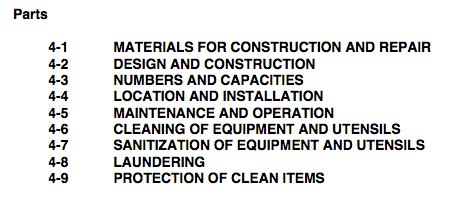
Keywords
Keywords, such as 'Fingernails' in §2-302.11 and 'Jewelry' in §2-303.11, help to further narrow down the section of the code. This enables the reader to review a desired section of the Code more quickly. The photo album below illustrates how the keywords are listed differently in the hard copy pdf version of the Code versus the html version.
 |
Turn the pages by clicking on the right or left side of each page. |
|
This content requires JavaScript enabled.
|
|
Violations
In response to the desire to allow discretion when encountering a violation, there is the convention of designating certain code provisions as non critical rather than critical or with the Swing designation permitting it to be either critical or non critical depending on the situation.
Requirements contained in the Code are presented as being in one of three categories of importance: critical; "swing" (i.e., those that may or may not be critical depending on the circumstances); and noncritical. An asterisk * after a tagline (which is the language immediately following a section number that introduces the subject of the section) indicates that all of the provisions within that section are critical unless otherwise indicated, as follows:
Any provisions that are "swing" items, are followed by the bold, superscripted letter S and any provisions that are noncritical are followed by the bold, superscripted letter N.

Any unmarked provisions within a section that has an asterisked tagline are critical. All provisions following a tagline that is not marked with an asterisk are noncritical.

Italics
Portions of some sections are written in italics. These provisions are not requirements, but are provided to convey relevant information about specific exceptions and alternative means for compliance. An italicized provision is not, itself, debitable. It allows some practice which, if not done according to the conditions stated, violates the general requirement.
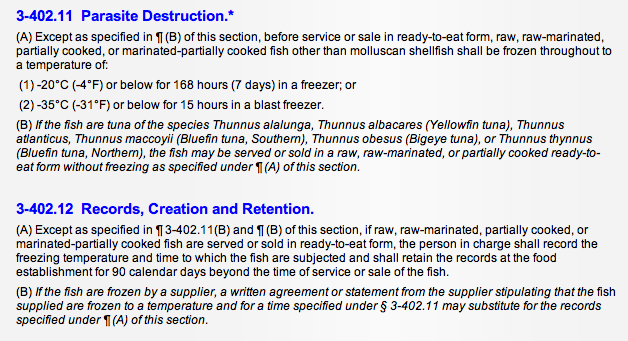
Language Style
Certain words used throughout the Code have very specific meanings and the language style adopted by the Code is based on Robert Marineau's writing format for regulations.
- "Shall" is an imperative or command.
- "May not" is absolute prohibition.
- "May" is permissive.
- "Means" indicates fact.
In the image below, the use of "shall" in paragraph A means that food MUST be obtained from approved sources. The language "may not" in paragraph B indicates that food prepared in a private home is PROHIBITED from being used or offered for human consumption in a food establishment. Finally, in paragraph C, "may" indicates that fish that are intended to be eaten raw are PERMITTED to be offered for sale or service under conditions further specified in §3-402.11 and §3-402.12.
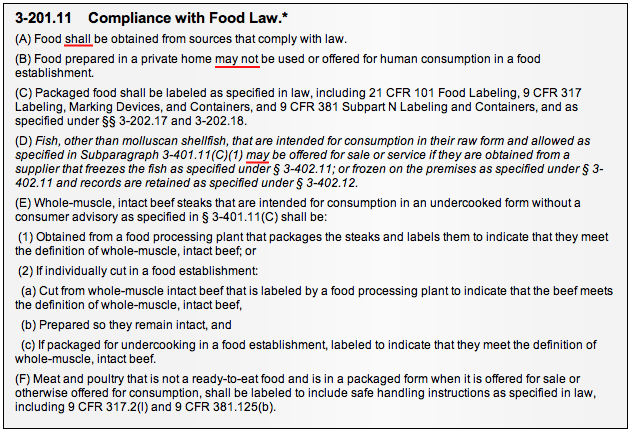
Internal Cross Referencing
Cross referencing is prevalent throughout the code. To know where certain violations should be debited, the context and language used will guide you.
A code section preceded by the phrase "as specified in" refers to another section of the code or a document outside of the code for additional information to help you determine whether the item is in or out of compliance.
A provision that follows a statement such as "as specified in…" becomes an integral part of the Section. "In" is used (as opposed to "under") because the document being referenced is outside the Code (and unto itself not debitable) and therefore needs to be brought into the requirement. For instance, a reference may be made to a local plumbing code and plumbing must meet the specifications of that code.
Common examples of documents being referenced include "law" and the Code of Federal Regulations (CFR) as illustrated below.

"Under" indicates where a violation is properly recorded against the Code provision that follows "as specified under". A provision that follows a statement such as "as specified under" is referenced for information or in order to appropriately debit the provision. You must read the phrase in the context of the entire provision to make that determination. See examples below.
